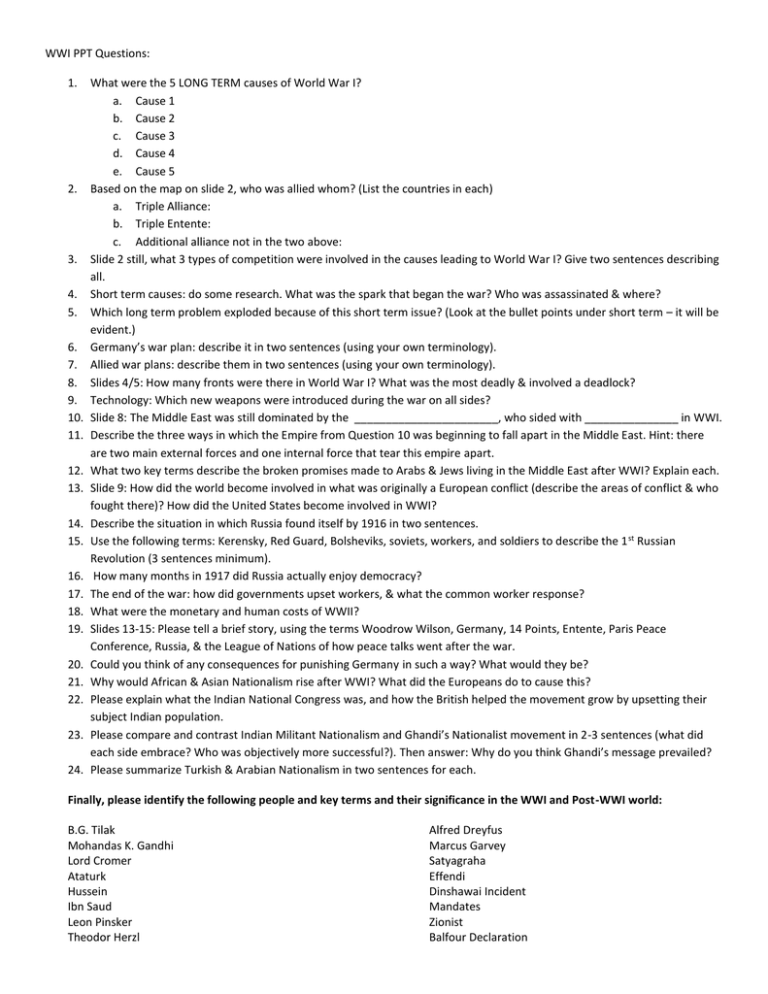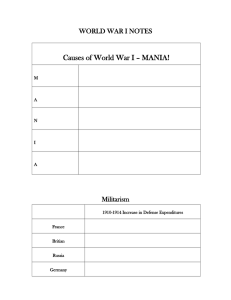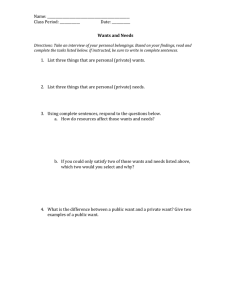WWI PPT Questions: a. Cause 1 b. Cause 2
advertisement

WWI PPT Questions: 1. 2. 3. 4. 5. 6. 7. 8. 9. 10. 11. 12. 13. 14. 15. 16. 17. 18. 19. 20. 21. 22. 23. 24. What were the 5 LONG TERM causes of World War I? a. Cause 1 b. Cause 2 c. Cause 3 d. Cause 4 e. Cause 5 Based on the map on slide 2, who was allied whom? (List the countries in each) a. Triple Alliance: b. Triple Entente: c. Additional alliance not in the two above: Slide 2 still, what 3 types of competition were involved in the causes leading to World War I? Give two sentences describing all. Short term causes: do some research. What was the spark that began the war? Who was assassinated & where? Which long term problem exploded because of this short term issue? (Look at the bullet points under short term – it will be evident.) Germany’s war plan: describe it in two sentences (using your own terminology). Allied war plans: describe them in two sentences (using your own terminology). Slides 4/5: How many fronts were there in World War I? What was the most deadly & involved a deadlock? Technology: Which new weapons were introduced during the war on all sides? Slide 8: The Middle East was still dominated by the _______________________, who sided with _______________ in WWI. Describe the three ways in which the Empire from Question 10 was beginning to fall apart in the Middle East. Hint: there are two main external forces and one internal force that tear this empire apart. What two key terms describe the broken promises made to Arabs & Jews living in the Middle East after WWI? Explain each. Slide 9: How did the world become involved in what was originally a European conflict (describe the areas of conflict & who fought there)? How did the United States become involved in WWI? Describe the situation in which Russia found itself by 1916 in two sentences. Use the following terms: Kerensky, Red Guard, Bolsheviks, soviets, workers, and soldiers to describe the 1 st Russian Revolution (3 sentences minimum). How many months in 1917 did Russia actually enjoy democracy? The end of the war: how did governments upset workers, & what the common worker response? What were the monetary and human costs of WWII? Slides 13-15: Please tell a brief story, using the terms Woodrow Wilson, Germany, 14 Points, Entente, Paris Peace Conference, Russia, & the League of Nations of how peace talks went after the war. Could you think of any consequences for punishing Germany in such a way? What would they be? Why would African & Asian Nationalism rise after WWI? What did the Europeans do to cause this? Please explain what the Indian National Congress was, and how the British helped the movement grow by upsetting their subject Indian population. Please compare and contrast Indian Militant Nationalism and Ghandi’s Nationalist movement in 2-3 sentences (what did each side embrace? Who was objectively more successful?). Then answer: Why do you think Ghandi’s message prevailed? Please summarize Turkish & Arabian Nationalism in two sentences for each. Finally, please identify the following people and key terms and their significance in the WWI and Post-WWI world: B.G. Tilak Mohandas K. Gandhi Lord Cromer Ataturk Hussein Ibn Saud Leon Pinsker Theodor Herzl Alfred Dreyfus Marcus Garvey Satyagraha Effendi Dinshawai Incident Mandates Zionist Balfour Declaration


